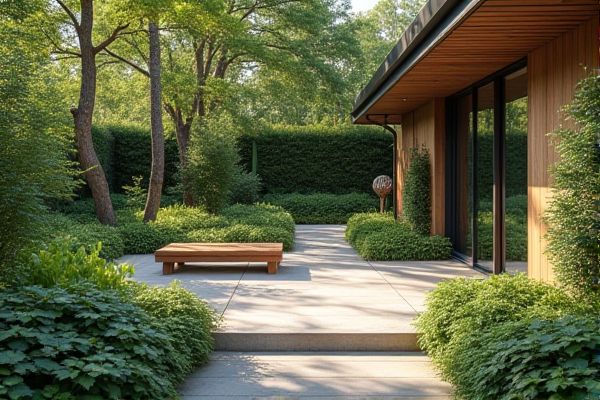
Cottage gardens feature dense, colorful plantings with a charming, informal aesthetic that emphasizes native and flowering plants, creating a relaxed and inviting atmosphere. Modern gardens focus on clean lines, minimalistic design, and often incorporate sleek materials and structured layouts to complement contemporary homes--discover how to choose the best style for your outdoor space by reading the full article.
Table of Comparison
| Feature | Cottage Garden | Modern Garden |
|---|---|---|
| Design Style | Informal, dense planting | Minimalist, clean lines |
| Plant Selection | Mix of perennials, herbs, flowers | Structured shrubs, grasses, succulents |
| Color Scheme | Varied, vibrant, multi-colored | Neutral tones, monochromatic |
| Pathways | Curved, natural materials | Straight, geometric patterns |
| Maintenance | Moderate to high | Low to moderate |
| Furniture & Decor | Vintage, rustic | Sleek, contemporary |
| Purpose | Casual, multi-use space | Stylized, functional space |
| Examples | Wildflowers, climbing roses, lavender | Boxwood hedges, ornamental grasses, concrete |
Introduction to Cottage and Modern Gardens
Cottage gardens feature informal layouts with densely planted flowers, herbs, and vegetables, emphasizing biodiversity and a nostalgic charm. Modern gardens prioritize clean lines, minimalism, and sustainable materials, often incorporating native plants for water efficiency. Understanding these contrasting styles helps in choosing a garden that fits aesthetic preferences and environmental goals.
Defining Features of Cottage Gardens
Cottage gardens are defined by their informal design, dense planting, and a blend of flowers, herbs, and vegetables that create a charming, whimsical atmosphere. Characterized by winding paths, mixed borders, and an abundance of traditional plants like roses, hollyhocks, and lavender, these gardens emphasize biodiversity and natural beauty. Unlike modern gardens that prioritize minimalism and structure, cottage gardens celebrate organic growth and a nostalgic, rustic aesthetic.
Key Elements of Modern Gardens
Modern gardens emphasize clean lines, minimalistic design, and functional spaces often incorporating geometric shapes and neutral color palettes. Key elements include sustainable materials, integrated lighting, water features, and low-maintenance plants such as ornamental grasses and succulents. Technology integration with smart irrigation systems and outdoor living areas further defines the modern garden aesthetic.
Historical Origins and Influences
Cottage gardens originated in 16th-century England, characterized by informal designs, dense planting of flowers and edible plants, and influences from rural working-class traditions. Modern gardens stem from 20th-century design principles emphasizing minimalism, clean lines, and functionality, often influenced by movements such as Bauhaus and mid-century modernism. Your choice between the two styles reflects a preference for either nostalgic, naturalistic aesthetics or contemporary, structured landscapes.
Plant Selection and Variety
Cottage gardens prioritize a diverse mix of flowering plants such as roses, foxgloves, hollyhocks, and lavender, creating a lush, informal, and romantic atmosphere with an emphasis on continuous blooms. Modern gardens favor sleek, minimalist plant selections like ornamental grasses, succulents, and structural perennials such as hostas and agaves, emphasizing clean lines, texture, and low-maintenance varieties. The choice between both styles hinges on desired aesthetics and gardening effort, with cottage gardens embracing variety and color, and modern gardens focusing on simplicity and architectural form.
Layout and Design Principles
Cottage gardens emphasize informal, densely planted layouts with meandering paths and mixed flower beds that create a natural, whimsical appearance. Modern gardens prioritize clean lines, open spaces, and minimalistic design, often featuring geometric shapes and a limited plant palette to emphasize simplicity and structure. The contrasting design principles reflect the cottage garden's focus on organic, eclectic aesthetics versus the modern garden's emphasis on order and functionality.
Maintenance and Upkeep
Cottage gardens typically require more frequent maintenance due to their dense planting and diverse species, including regular pruning, deadheading, and weeding to preserve their charming, untamed appearance. Modern gardens emphasize minimal upkeep with streamlined plant choices, hardscaping features, and efficient irrigation systems, reducing watering and weeding time. Your choice depends on how much time you can dedicate to upkeep and whether you prefer a lush, informal look or a clean, structured aesthetic.
Aesthetic Appeal and Atmosphere
Cottage gardens offer a charming, informal aesthetic with densely planted flowers and natural, whimsical atmospheres that evoke nostalgia and rustic warmth. Modern gardens emphasize sleek lines, minimalistic design, and structured plantings, creating a clean, sophisticated ambiance suited for contemporary lifestyles. Your choice depends on whether you prefer cozy, vibrant spaces or streamlined, elegant outdoor environments.
Environmental Impact and Sustainability
Cottage gardens promote biodiversity through diverse native plants and natural pest control methods, reducing chemical usage and supporting local ecosystems. Modern gardens often incorporate efficient irrigation systems and drought-resistant plants, minimizing water consumption and enhancing sustainability. Both garden styles contribute to environmental conservation, but cottage gardens emphasize ecological harmony while modern gardens prioritize resource efficiency.
Choosing the Right Style for Your Home
A cottage garden offers a charming, informal style filled with dense, colorful blooms and naturalistic plant arrangements, ideal for creating a cozy, whimsical atmosphere. Modern gardens emphasize clean lines, minimalistic design, and structured plantings, perfect for homes with contemporary architecture seeking simplicity and elegance. Consider your home's architectural style and your personal preferences to choose a garden that enhances your outdoor living space and reflects your lifestyle.
 homyna.com
homyna.com